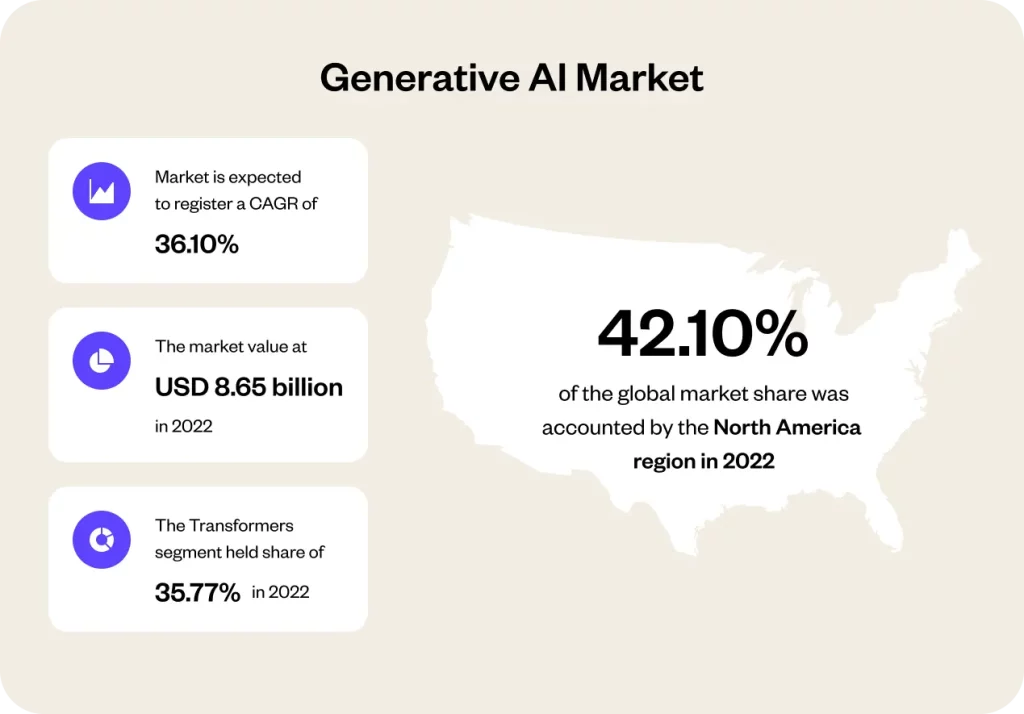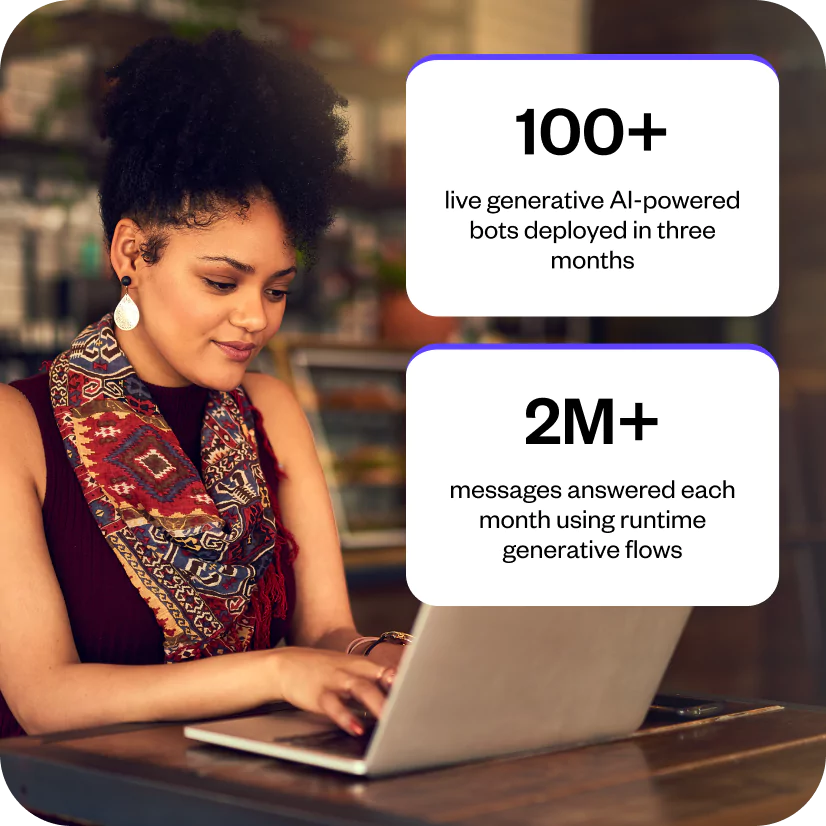Are you navigating the ever-expanding technological landscape? Look no further than Artificial Intelligence (AI) trends – your essential guide. A striking insight from a McKinsey Report underscores this: 40% of surveyed leaders confirm their organizations are ramping up investments in AI, primarily sparked by the rapid advancements in generative AI. Moreover, one-third of these respondents regularly use generative AI in at least one business function.
Harnessing AI in 2024: Emerging trends and their impact on customer-focused businesses
This makes it vital to understand what is the AI trend and how AI trends are emerging as pivotal elements, steering us towards what is increasingly recognized as the next big thing in technology.
Once a mere figment of futuristic imagination, AI has now intricately woven itself into the fabric of our daily lives and the heart of business ecosystems. In this blog, we dive into the AI trends of 2024, the ones that will make significant waves. Tailored for tech enthusiasts, business strategists, and the intellectually curious alike, this exploration aims to provide a comprehensive overview of the groundbreaking developments in AI. We’ll shed light on how AI trends are not just influencing our current reality but are also paving the way for an advanced, interconnected future.
Top AI statistics and global market size, along with its forecast
The rapid evolution of Artificial Intelligence (AI) is not just a phenomenon—it’s a revolution that’s reshaping industries around the globe. From enhancing customer service to revolutionizing supply chain operations, AI’s applications are as diverse as they are transformative. A survey published on Forbes Advisor highlights the most common AI use cases in business: customer service, cybersecurity and fraud management, customer relationship management (CRM), digital personal assistants, inventory management, content production, product recommendations, accounting, supply chain operations, recruitment, talent sourcing, and audience segmentation.
Source: Forbes Advisor
AI is driving unprecedented innovation, efficiency, and automation across various sectors. Here are some key AI statistics that demonstrate the profound influence of AI on businesses, the economy, and our daily lives:
- Market growth: AI is projected to grow at an impressive Compound Annual Growth Rate (CAGR) of 37.3% from 2023 to 2030.
- Business adoption: 97% of business owners believe that ChatGPT, a language model built using generative AI, will benefit their businesses in multiple ways.
- Enhancing customer relationships: More than 60% of business owners agree that AI can significantly improve customer relationships.
- Job creation: AI is projected to create approximately 97 million new jobs, countering workforce displacement concerns.
- Boosting productivity: 64% of businesses expect AI to increase productivity.
As we look towards the future, the AI market is poised for astonishing growth. According to PwC survey, AI could contribute up to $15.7 trillion to the global economy in 2030. This growth spans many industries, from supply chains and marketing to product development, research, and analysis.
Source: Next Move Strategy Consulting
Emerging AI trends such as chatbots, image-generating AI, and mobile applications are among the major forces propelling this growth. These innovations enhance current technologies and pave the way for new advancements and applications of AI.
9 AI trends to look out for in 2024
Artificial Intelligence (AI) stands as a beacon of continuous revolution in the dynamic world of technology. Its rapid advancement, fueled by the integration of disruptive technologies, is not just reshaping but redefining the business landscape. As we look ahead, it’s clear that AI’s expanding capabilities will play a pivotal role in shaping the future. For businesses aiming to stay at the forefront of innovation, keeping abreast of these AI trends is not just beneficial—it’s essential.
Here are the 9 AI trends for 2024 that are driving this transformative journey:
- Exploring the creative frontiers of generative AI
- Understanding the shift to edge computing in AI
- Recognizing AI’s role in cybersecurity enhancement
- Embracing the evolution of AI in education
- Examining AI’s impact in manufacturing
- Evaluating AI-driven process automation benefits
- Exploring AI’s growing influence in healthcare
- Assessing AI trends in autonomous vehicles
- Enhancing customer service with AI support
Each AI trend represents a significant leap forward in how AI is applied and the value it brings to various industries. Let’s dive into each artificial intelligence trend and explore how they’re set to change the game in 2024.
1. Exploring the creative frontiers of generative AI
Unlike predictive AI, which makes forecasts based on existing data, Generative AI is a newer form of AI that uses machine learning to create fresh, original content. It learns from patterns in training data to produce entirely new outputs, with the boom starting from AI image generators and reaching a peak with the release of ChatGPT. Since then, Generative AI has become a buzzword, continuously growing in popularity and application.

Examples of generative AI:
- AI-generated text: From chatbots and website copy to cover letters and children’s books, Generative AI can produce a wide array of text content based on input prompts.
- AI-generated images: These tools can craft novel ideas from human language descriptions, spanning artistic creations to hyper-realistic visuals.
- AI-generated speech: AI voice generators transform text into audio with diverse language, voice, and accent options.
Why generative AI is gaining momentum:
- Accessibility and ease of use: Many Generative AI applications are user-friendly, making them accessible to a broad audience.
- Value to businesses and individuals: These tools offer tangible benefits, enhancing creativity and efficiency in various applications.
- Media hype: The growing media attention around AI has significantly increased awareness and popularity. A survey by Salesforce in 2023 highlights this AI trend, revealing that 70% of Gen Z report using Generative AI, with 52% trusting it to help them make informed decisions. Furthermore, 52% of users say they use Generative AI more now than when they first started.
Impact on businesses:
The implications of Generative AI for businesses are profound. From marketing and content creation to product design and customer engagement, these tools offer innovative solutions that save time and resources and open new creative avenues. The challenge and opportunity lie in harnessing this technology responsibly and effectively.
Looking ahead:
As Generative AI tools gain popularity and new applications emerge, the investment in this space is surging. The future of Generative AI seems boundless, with its potential to transform industries and redefine creativity and content generation.
Yellow.ai’s journey to 100+ generative AI bots and millions of messages

2. Understanding the shift to edge computing in AI
Edge AI, or AI at the edge, represents a significant shift in how AI operates. It involves implementing AI algorithms in an edge computing environment, enabling computations to be done close to where data is collected. This approach differs from traditional AI which relies on data being transmitted to centralized cloud systems.
Key features and benefits:
- Real-time processing: Edge AI processes data almost instantly, providing real-time feedback without requiring an internet connection.
- Efficiency and privacy: Data processed locally on edge devices enhances efficiency and privacy, as sensitive data may not need to leave the edge.
- Scalability and reduced latency: Edge AI supports scalability and reduces latency by offloading some tasks from cloud platforms, allowing for quicker analysis and decision-making.
Impact on businesses:
The integration of Edge AI brings high-performance computing capabilities directly to where sensors and IoT devices are located, offering real-time data processing. This advancement is essential for businesses looking to enhance operational efficiency, data security, and responsiveness in various applications.
Looking ahead:
As Edge AI continues to advance, its impact is set to expand across various sectors, including chatbots, IoT, and more. This technology will bring enhanced real-time processing capabilities to a multitude of applications, promising a future where local, immediate decision-making becomes a norm. The potential of Edge AI to revolutionize response times, data security, and operational efficiency is immense, signaling a transformative shift in how technology interacts with our world.
3. Recognizing AI’s role in cybersecurity enhancement
Adopting AI in cybersecurity is critical due to its advanced threat detection and response capabilities. Unlike traditional methods, AI can analyze vast data sets rapidly, identifying subtle anomalies that indicate potential threats. This proactive approach ensures that even the most sophisticated cyber attacks can be predicted and neutralized efficiently. For industries, staying updated with AI-driven security innovations is vital to safeguard against evolving cyber threats, making AI an essential element in modern cybersecurity strategies.
Powerful use cases:
AI brings transformative tools to cybersecurity:
- Facial recognition: Enhancing identity verification and access control.
- Cyber threat hunting: Proactively identifying potential threats before they manifest.
- Surveillance: Monitoring for unusual activities to prevent security breaches.
The impact:
AI-based cybersecurity is a formidable weapon against cyber criminals. It can detect vulnerabilities and thwart malicious attempts, safeguarding valuable data and digital assets. Organizations without AI-based cybersecurity measures face higher risks and rates of data breaches.
Future market outlook:
According to the Grand View Research report the global AI in the cybersecurity market is robust and growing. Valued at USD 16.48 billion in 2022, it’s projected to expand at a CAGR of 24.3% from 2023 to 2030. This growth is driven by advancing AI technologies like natural language processing (NLP) and machine learning (ML), highlighting the increasing reliance on AI to protect, detect, and respond to threats.
4. Embracing the evolution of AI in education
AI-led education in 2024 is not just a futuristic concept but a practical reality, profoundly influencing the educational landscape. With AI, educators can create personalized learning experiences, automate administrative tasks, and provide interactive learning environments, including AI-powered chatbots for student assistance. This integration of AI leads to innovative teaching methods and enhanced learning experiences.
Why AI-led education is gaining momentum:
The momentum behind AI in education is driven by its diverse applications, such as:
- Personalized learning: AI tailors educational content to individual learning styles and needs.
- Task automation: AI streamlines grading, creating presentations, and managing administrative tasks.
- Smart content: AI assists in developing innovative and engaging educational materials.
- 24/7 assistance with conversational AI: AI chatbots provide round-the-clock support to students, enhancing their learning experience.
Impact on businesses:
Educational businesses are leveraging AI to develop more advanced learning platforms and tools. These AI-driven solutions offer more effective, engaging, and personalized educational products and services, meeting diverse learning needs and enhancing educational content.
The future of AI-led education:
The future of AI in education looks promising, with continuous advancements poised to revolutionize traditional educational models. AI is set to play a pivotal role in creating more adaptive and responsive learning environments. This transformative potential is mirrored in the global e-learning market’s growth, valued at USD 213.32 billion in 2021. It’s estimated to grow at a CAGR of 14.02% during the forecast period (2022–2030), reflecting the increasing integration of AI in educational methodologies and tools.
Revolutionize learning experiences with 24/7 connected educational support – Explore Now
5. Examining AI’s impact in manufacturing
AI-empowered manufacturing marks significant strides in integrating predictive maintenance, cognitive computing, and intelligent machines. This technological advancement is greatly enhancing efficiency and quality control in manufacturing processes.
Momentum in AI-led manufacturing
The driving force behind AI’s increasing adoption in manufacturing lies in its ability to improve predictive maintenance, enhance quality control with automated image recognition, and optimize production through autonomous guided vehicles and effective demand forecasting.
Impact on businesses
In manufacturing, AI’s impact is multifaceted. It aids in swiftly reacting to market changes by analyzing customer data. AI-driven product development accelerates prototyping, reducing time and costs. By optimizing buyer journeys and customer experiences, AI leverages predictive analytics for effective targeting and demand forecasting. This leads to sustainable growth and helps convert customers into loyal brand advocates.
The future of AI in manufacturing
A Deloitte survey highlights that 93% of companies view AI as essential for their growth and innovation. This reflects AI’s potential to bring intelligent, efficient, and autonomous operations to the forefront of manufacturing.
Unlock competitive advantage with conversational AI in manufacturing – Explore Now
Process automation is a pivotal shift in modern business operations, blending technological advancements with strategic objectives. Its multifaceted applications across various sectors, from HR to marketing, highlight the transformative potential of automation, signaling a new era in business innovation. Process automation employs advanced technology for simple and complex tasks, automating manual processes to enhance efficiency and consistency, thus freeing human resources for more complex tasks.
Benefits of AI-driven process automation
- Cost efficiency: Reduces operational expenses by automating manual tasks.
- Accuracy and efficiency: Minimizes human errors and increases speed.
- Enhanced ROI and competitiveness: Improves returns on investment and customer experiences, fostering competitive advantages.
Impact on businesses
While distinct, artificial intelligence and process automation converge in several areas, including shared goals in enhancing business operations and automation. They intersect in data use, integration, scalability, continuous evolution, and decision-making support. Together, they form a powerful combination, maximizing business innovation and potential.
Future Scope
The deployment of AI and automation technologies promises to uplift the global economy and address challenges like declining productivity growth. These technologies can invigorate productivity, contributing significantly to economic growth and prosperity. Also, according to McKinsey research, AI and automation have the potential to reverse the decline of labour productivity growth, which was 2.4% before the 2008 financial crisis and went to 0.5% after the crisis. AI and automation can bring it back to 2% by 2030, with 60% of this increase from digital opportunities.
Related read: AI and automation in customer experience
7. Exploring AI’s growing influence in healthcare
The COVID-19 pandemic fundamentally altered healthcare, accelerating the shift towards contactless, digital treatments. As we enter 2024 and beyond, healthcare treatments are evolving rapidly, with robotics and AI at the helm, enhancing medical decision-making through machine learning
AI transforming healthcare
- Robot-assisted surgeries: Increasing implementation of AI-powered robotic devices in surgeries, enabling unprecedented doctor-machine collaboration.
- Home health monitoring: AI is revolutionizing patient health monitoring through wearables and WiFi-enabled devices, potentially reducing hospital visits.
- Chatbots and machine learning: AI chatbots are increasingly aiding healthcare professionals in diagnosing and managing patient care, making the process smoother and more efficient.
Impact on businesses in healthcare
The adoption of AI in healthcare is significantly impacting businesses in this sector. AI’s ability to enhance decision-making and improve patient care creates new opportunities for healthcare providers and tech companies. The integration of AI is improving patient outcomes and opening new markets and revenue streams, particularly in AI-driven diagnostics and telemedicine services.
The future of AI in healthcare
AI’s increasing role in healthcare is set to revolutionize patient care and the industry’s operational dynamics. With a growing disparity between patients and available healthcare services, AI is crucial in bridging this gap and driving market growth. Efforts to curb healthcare costs alongside expansive and complex datasets fuel AI’s market expansion. The AI in Healthcare market is projected to surge from USD 14.6 Billion in 2023 to USD 102.7 Billion by 2028, growing at a CAGR of 47.6% during this period.
Personalized healthcare is just a conversation away – Explore Now
8. Assessing AI trends in autonomous vehicles
As we venture into 2024, AI trends in autonomous vehicles (AVs) are advancing rapidly, bringing us closer to a future where self-driving cars are an everyday reality. These trends culminate in years of research and technological breakthroughs, focusing on improving safety, efficiency, and passenger experience.
Why AI in autonomous vehicles gaining momentum
- Enhanced safety features: AI in AVs increasingly focuses on improving safety through advanced driver-assistance systems (ADAS) and predictive analytics to prevent accidents.
- Improved navigation and decision-making: AI algorithms are becoming more sophisticated in processing real-time data for better navigation and decision-making in complex driving scenarios.
- Integration with smart city infrastructure: AVs are being designed to integrate seamlessly with innovative city ecosystems, communicating with traffic systems and other vehicles to optimize traffic flow and reduce congestion.
- Personalization of passenger experience: AI enables AVs to offer personalized experiences for passengers, from route preferences to in-vehicle entertainment and comfort settings.
Impact on industry
The rise of AI in autonomous vehicles is transforming the automotive industry and impacting the urban planning, logistics, and transportation sectors. It’s paving the way for new business models, such as mobility-as-a-service (MaaS), and reshaping the future of personal and commercial transportation.
Future outlook
The future of autonomous vehicles is promising, with AI continuing to push the boundaries of what’s possible. We’re likely to see more advanced levels of automation, greater adoption in public transportation, and continued integration with emerging technologies like 5G and IoT. Moreover, According to Meticulous Research, the automotive AI market is projected to grow at a CAGR of 39.8% from 2019 to 2027, reaching $15.9 billion by 2027.
9. Enhancing customer service with AI support
AI is increasingly pivotal in customer service, automating routine tasks while reserving complex issues for human expertise. AI systems can triage calls, provide personalized solutions, and generate detailed customer interaction reports. A Boston Consulting Group survey indicates that 95% of customer service leaders anticipate AI bots serving customers within the next three years.
Key Features:
- Automated responses: AI enables immediate responses to common customer queries.
- Personalization: AI systems learn from customer interactions to provide tailored support.
- Efficiency in handling queries: AI can manage numerous customer interactions simultaneously, improving operational efficiency.
Impact on businesses:
AI-enabled customer service significantly boosts engagement, leading to increased cross-sell and upsell opportunities while efficiently reducing the cost-to-serve. McKinsey’s research in global banking suggests that AI could yield up to $1 trillion in additional annual value, with customer service enhancements playing a major role. Businesses adopting AI in customer service report heightened customer satisfaction, reduced operational costs, and strengthened brand loyalty.
Future of AI in customer service:
The future looks towards more advanced AI integration, with systems becoming more empathetic and context-aware, bridging the gap between automated and human-like interactions.
Related read: How to improve customer service?
Use cases of AI chatbots in various industries
The year 2024 marks a turning point in how businesses interact and connect. At the heart of this transformation are AI chatbots, transcending traditional text-based dialogues to deliver rich, context-sensitive, and personalized user experiences.
Healthcare
- Patient triage: AI chatbots can quickly assess symptoms and guide patients to the appropriate level of care, enhancing triage efficiency.
- Deliver health information: Chatbots provide reliable health information, answer medical queries, and assist in health education.
- Facilitate appointment management: They streamline the appointment scheduling process, send reminders, and manage cancellations or reschedules.
- Mental health support: Chatbots offer mental health support, providing coping strategies and assistance in crises.
Finance
- Financial guidance: Chatbots offer personalized financial advice, assist in managing accounts, and answer banking queries.
- Risk assessment: They help in analyzing financial risks and providing insights for informed decision-making.
- Customer service: Chatbots enhance customer service in banking, answering queries, and guiding through services.
- Fraud detection: AI chatbots assist in identifying and preventing fraudulent activities in financial transactions.
Retail
Conversational AI chatbots are the most sought after technology by e-commerce retailers as they improve customer engagement as well as customer support, along with an increase in RoI by many folds compared to existing technology.
- Personalized shopping: Chatbots offer tailored product recommendations based on customer preferences and browsing history.
- Customer support: They handle inquiries, provide product information, and assist in order completion.
- Post-purchase support: Retail chatbots assist with order tracking, returns, and feedback collection.
- Quality assurance: Chatbots assist in monitoring quality standards throughout the manufacturing process.
Manufacturing
- Supply chain communication: They facilitate efficient communication across the supply chain, enhancing coordination.
- Inventory management: Chatbots assist in inventory tracking, reorder notifications, and stock-level inquiries.
- Maintenance support: They guide equipment maintenance and troubleshooting.
- Quality assurance: Chatbots assist in monitoring quality standards throughout the manufacturing process.
Travel
- Travel planning assistance: Travel chatbots help plan itineraries, offering travel recommendations and information.
- Booking support: They assist in booking flights, accommodations, and travel packages.
- Travel advisories: Chatbots provide real-time travel updates, advisories, and destination information.
- Local recommendations: Offer local recommendations for dining, attractions, and activities based on user preferences.
Utilities
- Customer queries management: Chatbots address customer questions about services, usage, and outages.
- Issue reporting: They facilitate reporting of service issues and schedule repair or maintenance.
- Billing information: Chatbots assist in bill inquiries, payment processing, and usage tracking.
- Energy saving tips: Provide tips and advice on energy conservation and efficient utility usage.
Identifying recent conversational AI trends
A decade ago, chatbots and AI-driven conversations were things of science fiction. Fast forward to 2023, when artificial intelligence has become the heart of technological innovation, integration of conversational AI has become a strategic focus of the companies aiming to enhance business efficiency and user experiences.
From basic automated responses to sophisticated, context-aware interactions, AI chatbots have transformed significantly. But the technology landscape is very dynamic and to cope with the technological advancements and to make the best of it, conversational AI trends are your one-stop shop.
Implementing these conversational AI trends can offer unprecedented user experiences, signifying a leap in how AI chatbots function and serve. Here are the latest conversational AI trends:
- Sophisticated omnichannel CX chatbots
- Voice will go hyper-local
- Conversational AI in gaming is on the rise
- Social media chatbots & conversational commerce
- Total experience
- Hyper automation
For a more comprehensive understanding of the recent trends in conversational AI, you can explore conversational AI trends.
How Yellow.ai can help level up your customer support experience?
In today’s competitive market, exceptional customer support is crucial. Yellow.ai, with its advanced AI-driven capabilities, offers a transformative solution for enhancing customer interactions and support efficiency. This platform streamlines processes and personalizes customer experiences, setting a new standard in customer service excellence. While these advancements are crucial, it’s important to delve into why leveling up customer support is essential in the current business climate.
Related read: How to Automate Customer Support?
The need to elevate customer support
- Delivering tailored customer experiences: Ensuring agents have comprehensive access to customer histories, including past interactions, for more personalized and relevant support.
- Improving support performance: Using automation to generate detailed analytics and reports, aiding in the continuous assessment and enhancement of agent performance.
- Streamlining query management: Implementing prioritization of queries, so critical issues receive immediate attention while managing other queries effectively.
- Enhancing operational efficiency: Automated systems enable handling more customer queries with fewer resources, improving overall support efficiency.
These enhancements in customer support are crucial for meeting and surpassing the evolving expectations of customers.
Level up your customer support with yellow.ai’s Digital Automation Platform (DAP)
Yellow.ai’s Dynamic Automation Platform (DAP) is expertly crafted to revolutionize customer support operations. Here are the key functionalities that enable it to elevate customer support:
- Self-Service for repetitive queries: Yellow.ai’s DAP offers an intuitive self-service option that allows customers to find quick solutions to common queries. This feature alleviates the burden on support agents by reducing the volume of routine inquiries, leading to more efficient query handling.
- Filtered agent queries: The platform smartly filters and directs only complex or specialized customer queries to human agents. This selective routing ensures agents focus on issues requiring personalized attention, thus optimizing their time and expertise.
- Automated ticketing system: Yellow.ai’s DAP streamlines the ticketing process with automation. It quickly categorizes and routes tickets, leading to prompt and organized issue resolutions, enhancing the overall customer support response time and quality.
Available integration for ticketing and live chats
- Freshchat
- Salesforce
- ServiceNow
- Intercom
- Zendesk
- Zoho live chat
- Genesys
- Nice InContact
- Amazon Connect
- Avaya
- Jira
- Freshdesk
Learn more about Yellow.ai integrations
- Intelligent agent handover: During transitions from AI to human agents, the platform ensures a smooth handover by providing agents with comprehensive historical context and AI-driven suggestions. This seamless transition equips agents with the necessary insights to offer effective support immediately.
- Personalized customer engagement: The platform provides a personalized experience to each customer by leveraging data from past interactions. This feature enables the system to engage customers with contextually relevant support, increasing satisfaction and loyalty.
- Easy integration with CRM apps: Yellow.ai’s DAP is designed for hassle-free integration with leading ticketing, live chat, and CRM applications. This compatibility ensures a unified customer support experience across various channels, enhancing the efficiency and consistency of support services.
Available integration for CRM
- Salesforce
- Dynamics 365
- Hubspot
- Epic
- Zoho
Learn more about Yellow.ai integrations
- Pre-built templates and flows: The platform offers pre-designed templates and workflows for key use cases, enabling rapid deployment of robust support solutions. These ready-to-use features reduce implementation time and accelerate the launch of high-quality customer support initiatives.
By incorporating these advanced features, Yellow.ai’s DAP significantly levels up the customer support function, making it more responsive, efficient, and customer-centric.
Conclusion: Embracing AI trends for a transformative future
As we wrap up our exploration of AI trends, from generative AI’s creative leaps to the efficiency of AI-driven process automation, it’s clear that each trend highlights the vast impact of AI. This exploration underlines a bright future for AI, with trends and surveys pointing towards a significant economic boost driven by AI advancements. It’s becoming increasingly evident that now is the time to integrate AI into all aspects of business operations, embracing its transformative potential to reshape and elevate the business landscape.
With AI-backed customer service and conversational AI, we’re seeing a new era of personalized, efficient customer experiences. Yellow.ai’s Dynamic Automation Platform (DAP) is a testament to this evolution, offering solutions that redefine customer support and enhance the way you work, learn, and interact with your customers.
Frequently asked questions (FAQs)
What are the current trends in AI?
The current trends in AI include a wide spectrum of technologies such as AutoML, Multi-modal AI, Explainable AI, Computer Vision, Neural Networks, Digital Twins, and so on. These AI trends drive sustainable growth for businesses across industries, redefining the way we work, learn, and interact with technology.
What are the trends in Gen AI?
One of the most significant trends in Gen AI is the remarkable progress in natural language processing. These AI systems can understand and generate human language, making them invaluable in applications such as chatbots, virtual assistants, and language translation.
What is the future of AI?
The future of AI in 2050 is uncertain, but it can be more advanced and integrated into our daily lives. AI could solve many of the world’s problems and create new opportunities for innovation and growth. However, ethical concerns and regulations will also play a crucial role in shaping the future of AI.
How can AI be used in business?
AI can help transform how businesses engage with customers, identify relevant insights, and improve the customer experience. Some benefits of leveraging AI for customer service include faster response times, 24/7 availability and support, and opportunities to offer tailored solutions based on customers’ specific needs.
What are AI 6 principles?
Microsoft outlines six key principles for responsible AI: accountability, inclusiveness, reliability and safety, fairness, transparency, and privacy and security.
What are the six key technologies of AI?
Six key technologies of AI are:
- Machine learning
- Natural language processing
- Computer vision
- Automation
- Speech recognition
- Pattern recognition
How is AI used in banking?
AI is used in banking to enhance efficiency, security, and customer experiences. It automates routine tasks like data entry and fraud detection, reducing operational costs. AI-driven chatbots provide 24/7 customer support.
How is AI used in retail?
There are a variety of ways that retail companies are cleverly utilizing artificial intelligence. Some of the more popular uses of AI in the retail industry include demand forecasting, cashier-less technology, automated inventory management, and customer sentiment analysis.























